Spring Boot 员工管理系统 Spring Boot 员工管理系统超详细教程(源码分享)
林深时不见鹿 人气:1员工管理系统
1、准备工作
资料下载
内含源码 + 笔记 + web素材
源码下载地址:
http://xiazai.jb51.net/202105/yuanma/javaguanli_jb51.rar

笔记

素材

源码

1.1、导入资源
将文件夹中的静态资源导入idea中
![[外链图片转存失败,源站可能有防盗链机制,建议将图片保存下来直接上传(img-FK4du48Q-1620304585032)(C:/Users/Administrator/AppData/Roaming/Typora/typora-user-images/image-20210503093036786.jpg)]](https://img.qb5200.com/download-x/20210510/31289.jpg)
位置如下

1.2、编写pojo层
员工表
//员工表
@Data
@NoArgsConstructor
public class Employee {
private Integer id;
private String lastName;
private String email;
private Integer gender; //性别 0 女, 1,男
private Department department;
private Date birth;
public Employee(Integer id, String lastName, String email, Integer gender, Department department) {
this.id = id;
this.lastName = lastName;
this.email = email;
this.gender = gender;
this.department = department;
this.birth = new Date();
}
}
部门表
//部门表
@Data
@AllArgsConstructor
@NoArgsConstructor
public class Department {
private int id; //部门id
private String departmentName; //部门名字
}
添加lombok依赖
<!--lombok-->
<dependency>
<groupId>org.projectlombok</groupId>
<artifactId>lombok</artifactId>
</dependency>
1.3、编写dao层
这里我们模拟数据库,springboot和数据库的连接在后序课程中。
部门dao
package com.kuang.dao;
import com.kuang.pojo.Department;
import org.springframework.stereotype.Repository;
import java.util.Collection;
import java.util.HashMap;
import java.util.Map;
//部门dao
@Repository
public class DepartmentDao {
//模拟数据库中的数据
private static Map<Integer, Department>departments = null;
static {
departments = new HashMap<Integer, Department>(); //创建一个部门表
departments.put(101,new Department(101,"教学部"));
departments.put(102,new Department(102,"市场部"));
departments.put(103,new Department(103,"教研部"));
departments.put(104,new Department(104,"运营部"));
departments.put(105,new Department(105,"后勤部"));
}
//获取所有的部门信息
public Collection<Department> getDepartments(){
return departments.values();
}
//通过id得到部门
public Department getDepartmentById(Integer id){
return departments.get(id);
}
}
员工dao
package com.kuang.dao;
import com.kuang.pojo.Department;
import com.kuang.pojo.Employee;
import org.springframework.beans.factory.annotation.Autowired;
import org.springframework.stereotype.Repository;
import java.util.Collection;
import java.util.HashMap;
import java.util.Map;
//员工dao
@Repository //被string托管
public class EmployeeDao {
//模拟数据库中的数据
private static Map<Integer, Employee> employees= null;
//员工所属的部门
@Autowired
private DepartmentDao departmentDao;
static {
employees = new HashMap<Integer,Employee>(); //创建一个部门表
employees.put(1001,new Employee( 1001,"AA","1622840727@qq.com",1,new Department(101,"教学部")));
employees.put(1002,new Employee( 1002,"BB","2622840727@qq.com",0,new Department(102,"市场部")));
employees.put(1003,new Employee( 1003,"CC","4622840727@qq.com",1,new Department(103,"教研部")));
employees.put(1004,new Employee( 1004,"DD","5628440727@qq.com",0,new Department(104,"运营部")));
employees.put(1005,new Employee( 1005,"FF","6022840727@qq.com",1,new Department(105,"后勤部")));
}
//主键自增
private static Integer ininId = 1006;
//增加一个员工
public void save(Employee employee){
if(employee.getId() == null){
employee.setId(ininId++);
}
employee.setDepartment(departmentDao.getDepartmentById(employee.getDepartment().getId()));
employees.put(employee.getId(),employee);
}
//查询全部的员工
public Collection<Employee>getALL(){
return employees.values();
}
//通过id查询员工
public Employee getEmployeeById(Integer id){
return employees.get(id);
}
//删除一个员通过id
public void delete(Integer id){
employees.remove(id);
}
}
2、首页实现
2.1、引入Thymeleaf
pom.xml导入依赖
<dependency>
<groupId>org.thymeleaf</groupId>
<artifactId>thymeleaf-spring5</artifactId>
</dependency>
<dependency>
<groupId>org.thymeleaf.extras</groupId>
<artifactId>thymeleaf-extras-java8time</artifactId>
</dependency>
2.2、编写MyMvcConfig
package com.kuang.config;
import org.springframework.context.annotation.Configuration;
import org.springframework.web.servlet.config.annotation.ViewControllerRegistry;
import org.springframework.web.servlet.config.annotation.WebMvcConfigurer;
//扩展使用SpringMVC
@Configuration
public class MyMvcConfig implements WebMvcConfigurer {
@Override
public void addViewControllers(ViewControllerRegistry registry) {
registry.addViewController("/").setViewName("index");
registry.addViewController("/index.html").setViewName("index");
}
}
更改静态资源路径

所有的静态资源都需要使用thymeleaf接管:@{}
application.properties 修改
# 关闭模板引擎的缓存 spring.thymeleaf.cache=false server.servlet.context-path=/kuang
2.3、测试首页
输入路径
http://localhost:8080/kuang/index.html

测试成功!
3、页面国际化
3.1、 File Encodings设置
先在IDEA中统一设置properties的编码问题!

编写国际化配置文件,抽取页面需要显示的国际化页面消息。我们可以去登录页面查看一下,哪些内容
我们需要编写国际化的配置!
3.2、配置文件编写
1、我们在resources资源文件下新建一个i18n目录,存放国际化配置文件
2、建立一个login.properties文件,还有一个login_zh_CN.properties;发现IDEA自动识别了我们要做国际化操作;文件夹变了!

3、我们可以在这上面去新建一个文件;

弹出如下页面:我们再添加一个英文的;
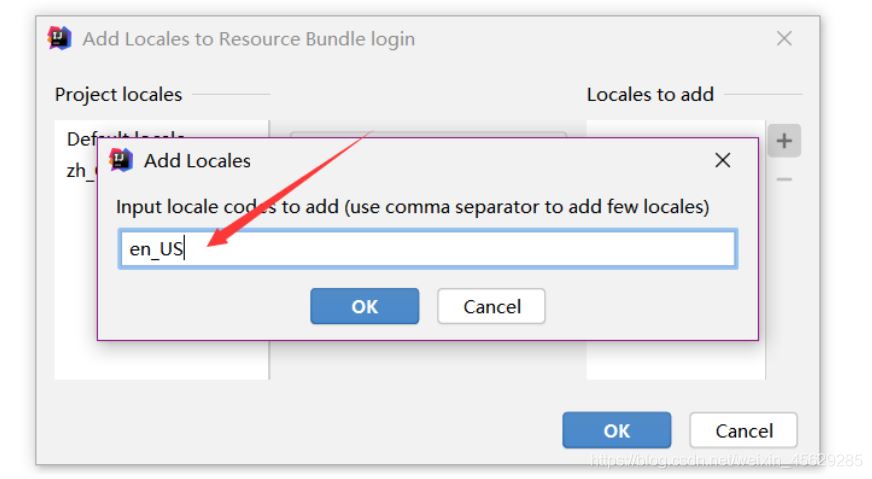
这样就快捷多了!

4、接下来,我们就来编写配置,我们可以看到idea下面有另外一个视图;

这个视图我们点击 + 号就可以直接添加属性了;我们新建一个login.tip,可以看到边上有三个文件框可以输入
在这里插入图片描述
我们添加一下首页的内容!
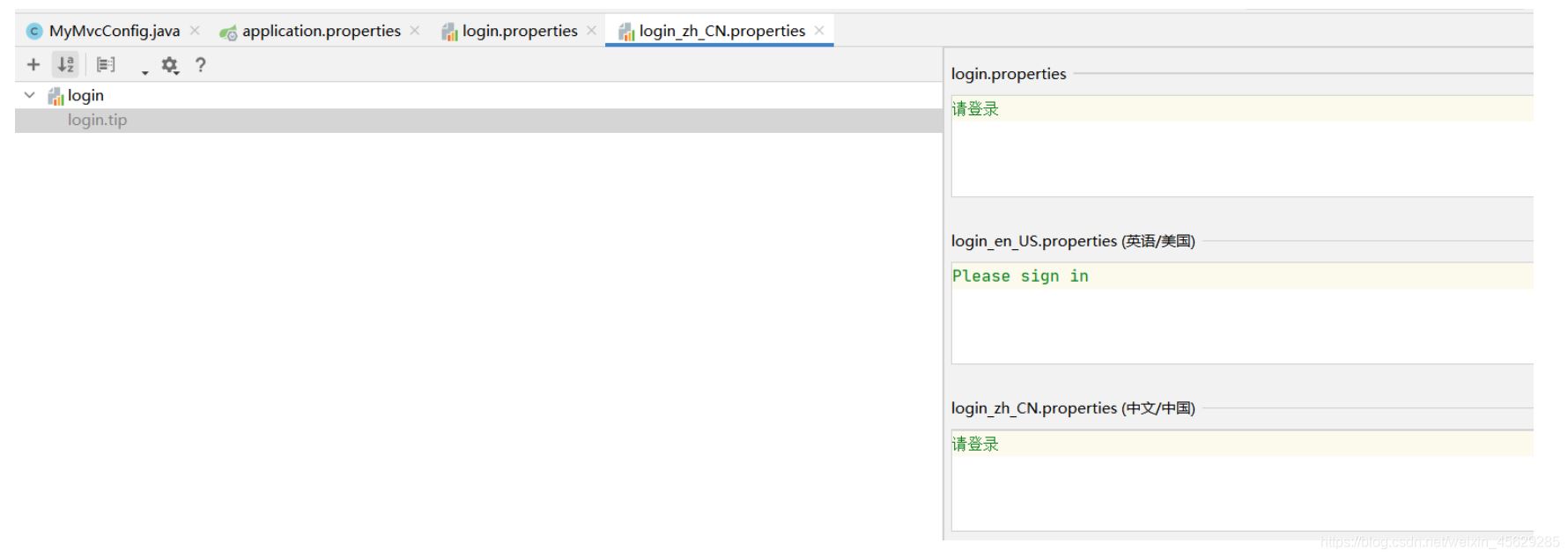
然后依次添加其他页面内容即可!

然后去查看我们的配置文件;
login.properties :默认
login.btn=登录 login.password=密码 login.remember=记住我 login.tip=请登录 login.username=用户名
英文:
login.btn=Sign in login.password=Password login.remember=Remember me login.tip=Please sign in login.username=Username
中文:
login.btn=登录 login.password=密码 login.remember=记住我 login.tip=请登录 login.username=用户名
OK,配置文件步骤搞定!
配置文件生效探究
我们去看一下SpringBoot对国际化的自动配置!这里又涉及到一个类:MessageSourceAutoConfiguration
里面有一个方法,这里发现SpringBoot已经自动配置好了管理我们国际化资源文件的组件 ResourceBundleMessageSource;
// 获取 properties 传递过来的值进行判断
@Bean
public MessageSource messageSource(MessageSourceProperties properties) {
ResourceBundleMessageSource messageSource = new ResourceBundleMessageSource();
if (StringUtils.hasText(properties.getBasename())) {
// 设置国际化文件的基础名(去掉语言国家代码的)
messageSource.setBasenames(
StringUtils.commaDelimitedListToStringArray(
StringUtils.trimAllWhitespace(properties.getBasename())));
}
if (properties.getEncoding() != null) {
messageSource.setDefaultEncoding(properties.getEncoding().name());
}
messageSource.setFallbackToSystemLocale(properties.isFallbackToSystemLocale());
Duration cacheDuration = properties.getCacheDuration();
if (cacheDuration != null) {
messageSource.setCacheMillis(cacheDuration.toMillis());
}
messageSource.setAlwaysUseMessageFormat(properties.isAlwaysUseMessageFormat());
messageSource.setUseCodeAsDefaultMessage(properties.isUseCodeAsDefaultMessage());
return messageSource;
}
我们真实的情况是放在了i18n目录下,所以我们要去配置这个messages的路径;
spring.messages.basename=i18n.login
配置页面国际化值
去页面获取国际化的值,查看Thymeleaf的文档,找到message取值操作为:#{…}。我们去页面测试下:
IDEA还有提示,非常智能的!
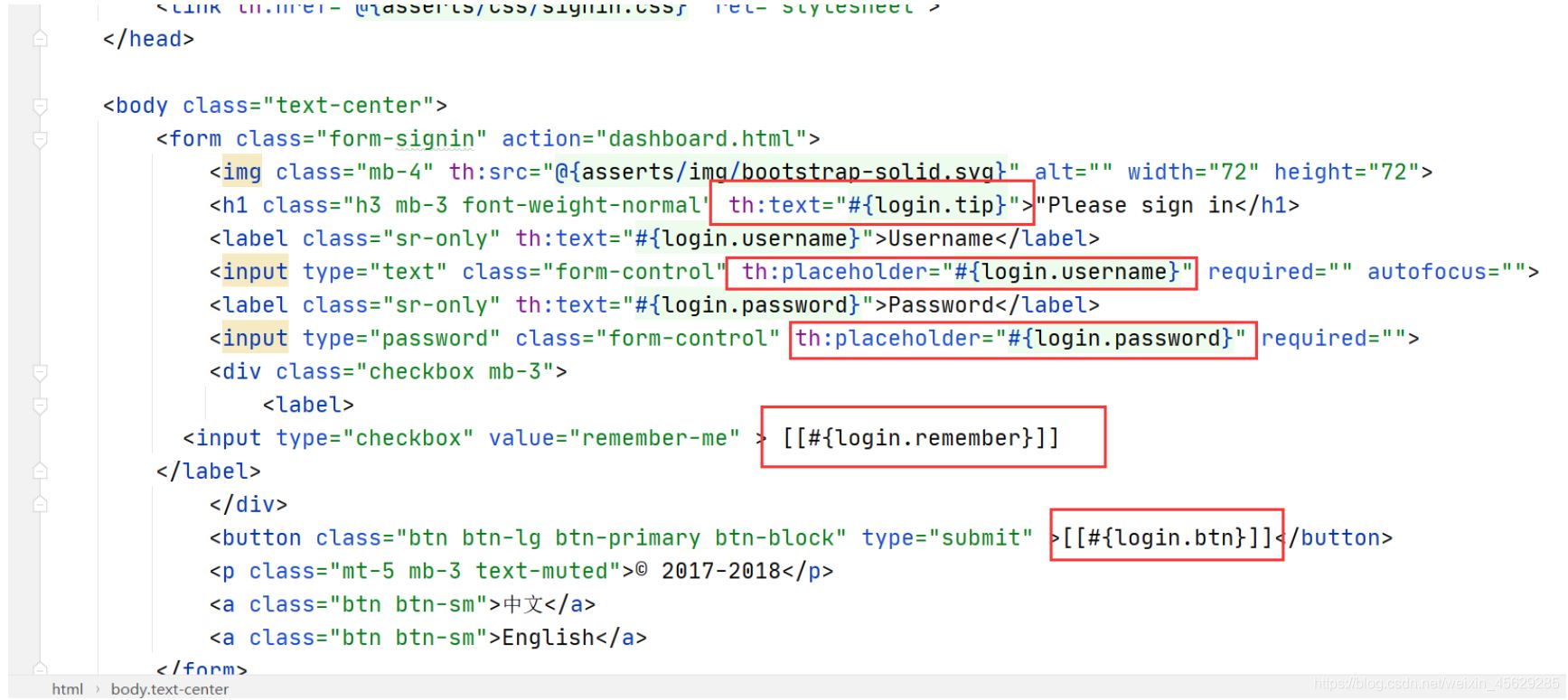
我们可以去启动项目,访问一下,发现已经自动识别为中文的了!

但是我们想要更好!可以根据按钮自动切换中文英文!
配置国际化解析
在Spring中有一个国际化的Locale (区域信息对象);里面有一个叫做LocaleResolver (获取区域信息对象)的解析器!
我们去我们webmvc自动配置文件,寻找一下!看到SpringBoot默认配置:
@Bean
@ConditionalOnMissingBean
@ConditionalOnProperty(prefix = "spring.mvc", name = "locale")
public LocaleResolver localeResolver() {
// 容器中没有就自己配,有的话就用用户配置的
if (this.mvcProperties.getLocaleResolver() == WebMvcProperties.LocaleResolver.FIXED) {
return new FixedLocaleResolver(this.mvcProperties.getLocale());
}
// 接收头国际化分解
AcceptHeaderLocaleResolver localeResolver = new AcceptHeaderLocaleResolver();
localeResolver.setDefaultLocale(this.mvcProperties.getLocale());
return localeResolver;
}
AcceptHeaderLocaleResolver 这个类中有一个方法
public Locale resolveLocale(HttpServletRequest request) {
Locale defaultLocale = this.getDefaultLocale();
// 默认的就是根据请求头带来的区域信息获取Locale进行国际化
if (defaultLocale != null && request.getHeader("Accept-Language") == null) {
return defaultLocale;
} else {
Locale requestLocale = request.getLocale();
List<Locale> supportedLocales = this.getSupportedLocales();
if (!supportedLocales.isEmpty() && !supportedLocales.contains(requestLocale)) {
Locale supportedLocale = this.findSupportedLocale(request, supportedLocales);
if (supportedLocale != null) {
return supportedLocale;
} else {
return defaultLocale != null ? defaultLocale : requestLocale;
}
} else {
return requestLocale;
}
}
}
那假如我们现在想点击链接让我们的国际化资源生效,就需要让我们自己的Locale生效!
我们去自己写一个自己的LocaleResolver,可以在链接上携带区域信息!
修改一下前端页面的跳转连接:
<!-- 这里传入参数不需要使用 ?使用 (key=value)-->
<a class="btn btn-sm" th:href="@{/index.html(l='zh_CN')}" rel="external nofollow" >中文</a>
<a class="btn btn-sm" th:href="@{/index.html(l='en_US')}" rel="external nofollow" >English</a>
我们去写一个处理的组件类!
package com.kuang.component;
import org.springframework.util.StringUtils;
import org.springframework.web.servlet.LocaleResolver;
import javax.servlet.http.HttpServletRequest;
import javax.servlet.http.HttpServletResponse;
import java.util.Locale;
//可以在链接上携带区域信息
public class MyLocaleResolver implements LocaleResolver {
//解析请求
@Override
public Locale resolveLocale(HttpServletRequest request) {
String language = request.getParameter("l");
Locale locale = Locale.getDefault(); // 如果没有获取到就使用系统默认的
//如果请求链接不为空
if (!StringUtils.isEmpty(language)){
//分割请求参数
String[] split = language.split("_");
//国家,地区
locale = new Locale(split[0],split[1]);
}
return locale;
}
@Override
public void setLocale(HttpServletRequest httpServletRequest, HttpServletResponse httpServletResponse, Locale locale) {
}
}
为了让我们的区域化信息能够生效,我们需要再配置一下这个组件!在我们自己的MvcConofig下添加bean;
@Bean
public LocaleResolver localeResolver(){
return new MyLocaleResolver();
}
我们重启项目,来访问一下,发现点击按钮可以实现成功切换!搞定收工!
注意点

4、登录+拦截器
4.1、登录
禁用模板缓存
说明:页面存在缓存,所以我们需要禁用模板引擎的缓存
#禁用模板缓存 spring.thymeleaf.cache=false
模板引擎修改后,想要实时生效!页面修改完毕后,IDEA小技巧 : Ctrl + F9 重新编译!即可生效!
登录
我们这里就先不连接数据库了,输入任意用户名都可以登录成功!
1、我们把登录页面的表单提交地址写一个controller!
<form class="form-signin" th:action="@{/user/login}" method="post">
//这里面的所有表单标签都需要加上一个name属性
</form>
2、去编写对应的controller
@Controller
public class LoginController {
@RequestMapping("/user/login")
public String login(
@RequestParam("username") String username ,
@RequestParam("password") String password,
Model model){
//具体的业务
if(!StringUtils.isEmpty(username)&&"123456".equals(password)){
return "redirect:/main.html";
}
else{
//告诉用户,你登录失败
model.addAttribute("msg","用户名或者密码错误!");
return "index";
}
}
}
OK ,测试登录成功!

3、登录失败的话,我们需要将后台信息输出到前台,可以在首页标题下面加上判断
<!--判断是否显示,使用if, ${}可以使用工具类,可以看thymeleaf的中文文档-->
<p style="color: red" th:text="${msg}" th:if="${not #strings.isEmpty(msg)}">
</p>
重启登录失败测试:
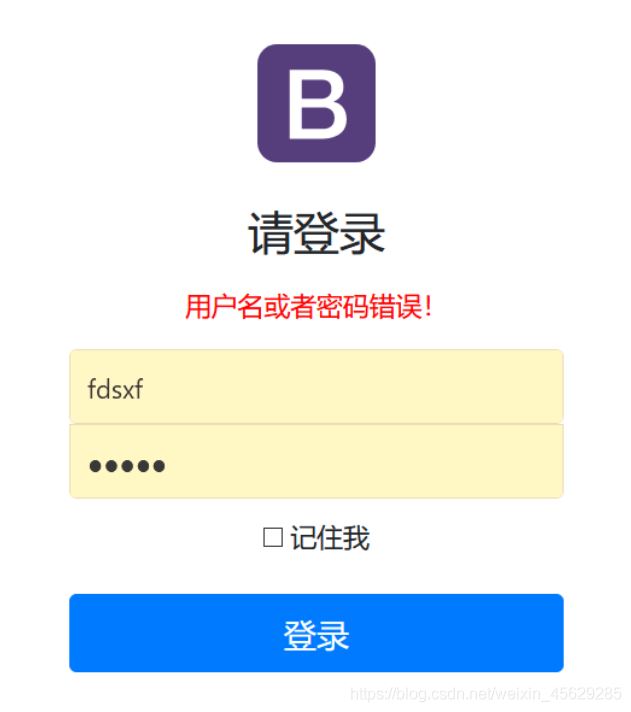
优化,登录成功后,由于是转发,链接不变,我们可以重定向到首页!
4、我们再添加一个视图控制映射,在我们的自己的MyMvcConfifig中:
registry.addViewController("/main.html").setViewName("dashboard");
5、将 Controller 的代码改为重定向;
//登录成功!防止表单重复提交,我们重定向 return "redirect:/main.html";
重启测试,重定向成功!后台主页正常显示!
4.2、登录拦截器
但是又发现新的问题,我们可以直接登录到后台主页,不用登录也可以实现!怎么处理这个问题呢?我
们可以使用拦截器机制,实现登录检查!
1、在LoginController添加serssion
session.setAttribute("loginUser",username);
2、自定义一个拦截器:
//自定义拦截器
public class LoginHandlerInterceptor implements HandlerInterceptor {
@Override
public boolean preHandle(HttpServletRequest request, HttpServletResponse response, Object handler) throws Exception {
//获取 loginUser 信息进行判断
Object user = request.getSession().getAttribute("loginUser");
if(user == null){//未登录,返回登录页面
request.setAttribute("msg","没有权限,请先登录");
request.getRequestDispatcher("/index.html").forward(request,response);
return false;
}else{
//登录,放行
return true;
}
}
}
3、然后将拦截器注册到我们的SpringMVC配置类当中!
@Override
public void addInterceptors(InterceptorRegistry registry) {
// 注册拦截器,及拦截请求和要剔除哪些请求!
// 我们还需要过滤静态资源文件,否则样式显示不出来
registry.addInterceptor(new LoginHandlerInterceptor())
.addPathPatterns("/**")
.excludePathPatterns("/index.html","/user/login","/","/css/*","/img/**","/js/**");
}
4、我们然后在后台主页,获取用户登录的信息
<!--后台主页显示登录用户的信息-->
[[${session.loginUser}]] <!--$取EL表达式-->
然后我们登录测试拦截!完美!
5、展示员工列表
5.1、员工列表页面跳转
我们在主页点击Customers,就显示列表页面;我们去修改下
1、将首页的侧边栏Customers改为员工管理
2、a链接添加请求
<a class="nav-link" th:href="@{/emps}" rel="external nofollow" rel="external nofollow" >员工管理</a>
3、将list放在emp文件夹下
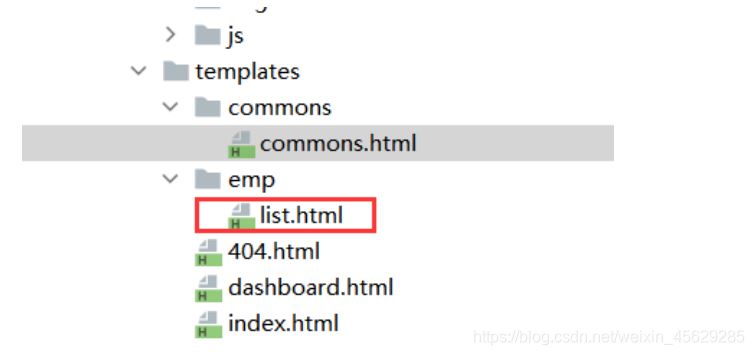
4、编写处理请求的controller
//员工列表
@Controller
public class EmployeeController {
@Autowired
EmployeeDao employeeDao;
@RequestMapping("/emps")
public String list(Model model){
Collection<Employee> employees = employeeDao.getALL();
model.addAttribute("emps",employees);
return "emp/list";
}
}
我们启动项目,测试一下看是否能够跳转,测试OK!我们只需要将数据渲染进去即可!
但是发现了一个问题,侧边栏和顶部都相同,我们是不是应该将它抽取出来呢?
5.2、Thymeleaf公共页面元素抽取
步骤:
1、抽取公共片段 th:fragment 定义模板名
2、引入公共片段 th:insert 插入模板名
实现:
1、我们来抽取一下,使用list列表做演示!我们要抽取头部nav标签,我们在dashboard中将nav部分定
义一个模板名;
<!--顶部导航栏-->
<nav class="navbar navbar-dark sticky-top bg-dark flex-md-nowrap p-0" th:fragment="topbar">
<a class="navbar-brand col-sm-3 col-md-2 mr-0" href="http://getbootstrap.com/docs/4.0/examples/dashboard/#" rel="external nofollow" rel="external nofollow" >[[${session.loginUser}]]</a> <!--$取EL表达式-->
<input class="form-control form-control-dark w-100" type="text" placeholder="Search" aria-label="Search">
<ul class="navbar-nav px-3">
<li class="nav-item text-nowrap">
<a class="nav-link" href="http://getbootstrap.com/docs/4.0/examples/dashboard/#" rel="external nofollow" rel="external nofollow" >注销</a>
</li>
</ul>
</nav>
2、然后我们在list页面中去引入,可以删掉原来的nav
<!--引入抽取的topbar-->
<!--模板名 : 会使用thymeleaf的前后缀配置规则进行解析 使用~{模板::标签名}-->
<!--顶部导航栏-->
<div th:insert="~{dashboard::topbar}"></div>
3、启动再次测试,可以看到已经成功加载过来了!
说明:
除了使用insert插入,还可以使用replace替换,或者include包含,三种方式会有一些小区别,可以见名
知义;
我们使用replace替换,可以解决div多余的问题,可以查看thymeleaf的文档学习
侧边栏也是同理,当做练手,可以也同步一下!
定义模板:
<!--侧边栏--> <nav th:fragment="sitebar" class="col-md-2 d-none d-md-block bg-light sidebar">
然后我们在list页面中去引入:
<!--顶部导航栏-->
<div th:replace="~{commons/commons::topbar}"></div>
<!--侧边栏-->
<div th:replace="~{commons/commons::sidebar}"></div>
启动再试试,看效果!
![[外链图片转存失败,源站可能有防盗链机制,建议将图片保存下来直接上传(img-MYb7uR0O-1620304585041)(%E5%91%98%E5%B7%A5%E7%AE%A1%E7%90%86%E7%B3%BB%E7%BB%9F.assets/image-20210504080516865.jpg)]](https://img.qb5200.com/download-x/20210510/31307.jpg)
我们发现一个小问题,侧边栏激活的问题,它总是激活第一个;按理来说,这应该是动态的才对!
为了重用更清晰,我们建立一个commons文件夹,专门存放公共页面;
![[外链图片转存失败,源站可能有防盗链机制,建议将图片保存下来直接上传(img-oOhXpYuM-1620304585042)(%E5%91%98%E5%B7%A5%E7%AE%A1%E7%90%86%E7%B3%BB%E7%BB%9F.assets/image-20210504080721577.jpg)]](https://img.qb5200.com/download-x/20210510/31308.jpg)
我们去页面中引入一下
<a th:class="${active=='list.html'?'nav-link active':'nav-link'}" th:href="@{/index.html}" rel="external nofollow" >
<svg xmlns="http://www.w3.org/2000/svg" width="24" height="24" viewBox="0 0 24 24" fill="none" stroke="currentColor" stroke-width="2" stroke-linecap="round" stroke-linejoin="round" class="feather feather-home">
<path d="M3 9l9-7 9 7v11a2 2 0 0 1-2 2H5a2 2 0 0 1-2-2z"></path>
<polyline points="9 22 9 12 15 12 15 22"></polyline>
</svg>
首页 <span class="sr-only">(current)</span>
</a>
<a th:class="${active=='list.html'?'nav-link active':'nav-link'}" th:href="@{/emps}" rel="external nofollow" rel="external nofollow" >
<svg xmlns="http://www.w3.org/2000/svg" width="24" height="24" viewBox="0 0 24 24" fill="none" stroke="currentColor" stroke-width="2" stroke-linecap="round" stroke-linejoin="round" class="feather feather-shopping-cart">
<circle cx="9" cy="21" r="1"></circle>
<circle cx="20" cy="21" r="1"></circle>
<path d="M1 1h4l2.68 13.39a2 2 0 0 0 2 1.61h9.72a2 2 0 0 0 2-1.61L23 6H6"></path>
</svg>
员工管理
</a>
我们先测试一下,保证所有的页面没有出问题!ok!
侧边栏激活问题:
1、将首页的超链接地址改到项目中
2、我们在a标签中加一个判断,使用class改变标签的值;
<div th:replace="~{commons/commons::topbar(active='main.html')}"></div>
<div th:replace="~{commons/commons::sidebar(active='list.html')}"></div>
3、修改请求链接
<thead>
<tr>
<th>id</th>
<th>lastName</th>
<th>email</th>
<th>gender</th>
<th>department</th>
<th>birth</th>
</tr>
</thead>
<tbody>
<tr th:each="emp:${emps}">
<td th:text="${emp.getId()}"></td>
<td th:text="${emp.getLastName()}"></td>
<td th:text="${emp.getEmail()}"></td>
<td th:text="${emp.getGender()==0?'女':'男'}"></td>
<td th:text="${emp.department.getDepartmentName()}"></td>
<td th:text="${#dates.format(emp.getBirth(),'yyyy-MM-dd HH:mm:ss')}"></td>
<td>
<button class="btn btn-sm btn-primary">编辑</button>
<button class="btn btn-sm btn-danger">删除</button>
</td>
</tr>
</tbody>
4、我们刷新页面,去测试一下,OK,动态激活搞定!
5.3、员工信息页面展示
现在我们来遍历我们的员工信息!顺便美化一些页面,增加添加,修改,删除的按钮!
<h2><a class="btn btn-sm btn-success" th:href="@{/emp}" rel="external nofollow" >添加员工</a></h2>
![[外链图片转存失败,源站可能有防盗链机制,建议将图片保存下来直接上传(img-3zTWfpyn-1620304585042)(%E5%91%98%E5%B7%A5%E7%AE%A1%E7%90%86%E7%B3%BB%E7%BB%9F.assets/image-20210504081556725.jpg)]](https://img.qb5200.com/download-x/20210510/31309.jpg)
OK,显示全部员工OK!
6、添加员工实现
6.1、表单及细节处理
1、将添加员工信息改为超链接
//to员工添加页面
@GetMapping("/emp")
public String toAddPage(){
return "emp/add";
}
2、编写对应的controller
<form th:action="@{/emp}" method="post" >
<div class="form-group" ><label>LastName</label>
<input class="form-control" placeholder="kuangshen" type="text" name="lastName">
</div>
<div class="form-group" ><label>Email</label>
<input class="form-control" placeholder="24736743@qq.com" type="email" name="email">
</div>
<div class="form-group"><label>Gender</label><br/>
<div class="form-check form-check-inline">
<input class="form-check-input" name="gender" type="radio" value="1">
<label class="form-check-label">男</label>
</div>
<div class="form-check form-check-inline">
<input class="form-check-input" name="gender" type="radio" value="0">
<label class="form-check-label">女</label>
</div>
</div>
<div class="form-group" ><label>department</label>
<select class="form-control" name="department.id">
<option th:each="dept:${departments}" th:text="${dept.getDepartmentName()}" th:value="${dept.getId()}"></option>
</select>
</div>
<div class="form-group" >
<label >Birth</label>
<input class="form-control" placeholder="kuangstudy" type="text" name="birth">
</div>
<button class="btn btn-primary" type="submit">添加</button>
</form>
3、添加前端页面;复制list页面,修改即可
bootstrap官网文档 : https://v4.bootcss.com/docs/4.0/components/forms/
我们去可以里面找自己喜欢的样式!我这里给大家提供了编辑好的:
@GetMapping("/emp")
public String toAddPage(Model model){
//查询所有的部门信息
Collection<Department> departments = departmentDao.getDepartments();
model.addAttribute("departments",departments);
return "emp/add";
}
4、部门信息下拉框应该选择的是我们提供的数据,所以我们要修改一下前端和后端
Controller
<select class="form-control" name="department.id">
<option th:each="dept:${departments}" th:text="${dept.getDepartmentName()}" th:value="${dept.getId()}"></option>
</select>
前端
<form th:action="@{/emp}" method="post"> 1
OK,修改了controller,重启项目测试!
6.2、具体添加功能
1、修改add页面form表单提交地址和方式
<form th:action="@{/emp}" method="post">
2、编写controller;
//员工添加功能
//接收前端传递的参数,自动封装成为对象[要求前端传递的参数名,和属性名一致]
@PostMapping ("/emp")
public String addEmp(Employee employee){
//保存员工的信息
System.out.println(employee);
employeeDao.save(employee);
// 回到员工列表页面,可以使用redirect或者forward,就不会被视图解析器解析
return "redirect:/emps";
}
![[外链图片转存失败,源站可能有防盗链机制,建议将图片保存下来直接上传(img-b6fVRToh-1620304585042)(%E5%91%98%E5%B7%A5%E7%AE%A1%E7%90%86%E7%B3%BB%E7%BB%9F.assets/image-20210504161017922.jpg)]](https://img.qb5200.com/download-x/20210510/31310.jpg)
回忆:重定向和转发以及 /的问题?
时间格式问题

生日我们提交的是一个日期 , 我们第一次使用的 / 正常提交成功了,后面使用 - 就错误了,所以这里面
应该存在一个日期格式化的问题;
SpringMVC会将页面提交的值转换为指定的类型,默认日期是按照 / 的方式提交 ; 比如将2019/01/01
转换为一个date对象。
那思考一个问题?我们能不能修改这个默认的格式呢?
这个在配置类中,所以我们可以自定义的去修改这个时间格式化问题,我们在我们的配置文件中修改一
下;
spring.mvc.date-format=yyyy-MM-dd
这样的话,我们现在就支持 - 的格式了,但是又不支持 / 了 , 2333吧
测试OK!
7、修改员工信息
逻辑分析:
我们要实现员工修改功能,需要实现两步;
1、点击修改按钮,去到编辑页面,我们可以直接使用添加员工的页面实现
2、显示原数据,修改完毕后跳回列表页面!
实现
1、我们去实现一下,首先修改跳转链接的位置;
<a class="btn btn-sm btn-primary" th:href="@{/emp/}+${emp.getId()}" rel="external nofollow" >编辑</a>
2、编写对应的controller
//员工修改页面
@GetMapping("/emp/{id}")
public String toUpdateEmp(@PathVariable("id") Integer id,Model model){
Employee employee = employeeDao.getEmployeeById(id);
model.addAttribute("emp",employee);
//查询所有的部门信息
Collection<Department> departments = departmentDao.getDepartments();
model.addAttribute("departments",departments);
return "emp/update";
}
3、我们需要在这里将add页面复制一份,改为update页面;需要修改页面,将我们后台查询数据回显
<form th:action="@{/emp}" method="post" >
<input type="hidden" name="id" th:value="${emp.getId()}">
<div class="form-group" ><label>LastName</label>
<input th:value="${emp.getLastName()}" class="form-control" placeholder="kuangshen" type="text" name="lastName">
</div>
<div class="form-group" ><label>Email</label>
<input th:value="${emp.getEmail()}" class="form-control" placeholder="24736743@qq.com" type="email" name="email">
</div>
<div class="form-group"><label>Gender</label><br/>
<div class="form-check form-check-inline">
<input th:checked="${emp.getGender()==1}" class="form-check-input" name="gender" type="radio" value="1">
<label class="form-check-label">男</label>
</div>
<div class="form-check form-check-inline">
<input th:checked="${emp.getGender()==0}" class="form-check-input" name="gender" type="radio" value="0">
<label class="form-check-label">女</label>
</div>
</div>
<div class="form-group" ><label>department</label>
<select class="form-control" name="department.id">
<option th:selected="${dept.id==emp.getDepartment().getId()}" th:each="dept:${departments}" th:text="${dept.getDepartmentName()}" th:value="${dept.getId()}"></option>
</select>
</div>
<div class="form-group" >
<label >Birth</label>
<input th:value="${#dates.format(emp.birth,'yyyy-MM-dd HH:mm')}" class="form-control" placeholder="2021-02-02" type="text" name="birth">
</div>
<button class="btn btn-primary" type="submit">修改</button>
</form>
数据回显OK!
8、删除员工实现
1、list页面,编写提交地址
<a class="btn btn-sm btn-danger" th:href="@{/delEmp/}+${emp.getId()}" rel="external nofollow" >删除</a>
2、编写Controller
//删除员工
@GetMapping("/delEmp/{id}")
public String delEmp(@PathVariable("id") Integer id){
employeeDao.delete(id);
return "redirect:/emps";
}
测试OK!
9、404及注销
404
我们只需要在模板目录下添加一个error文件夹,文件夹中存放我们相应的错误页面;
比如404.html 或者 4xx.html 等等,SpringBoot就会帮我们自动使用了!
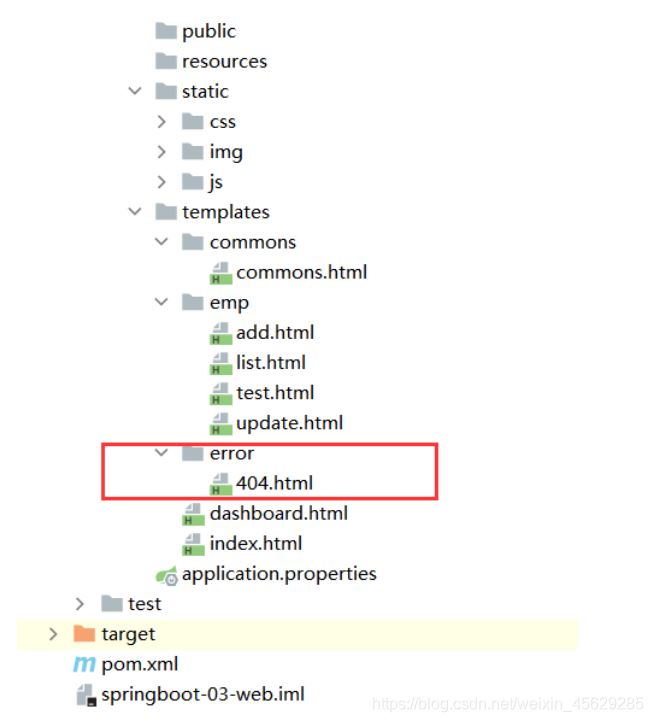
测试使用!
注销
1、注销请求
<a class="nav-link" th:href="@{/user/logout}" rel="external nofollow" >注销</a>
2、对应的controller
```java
@RequestMapping("/user/logout")
public String logout(HttpSession session){
session.invalidate();
return "redirect:/index.html";
}
加载全部内容